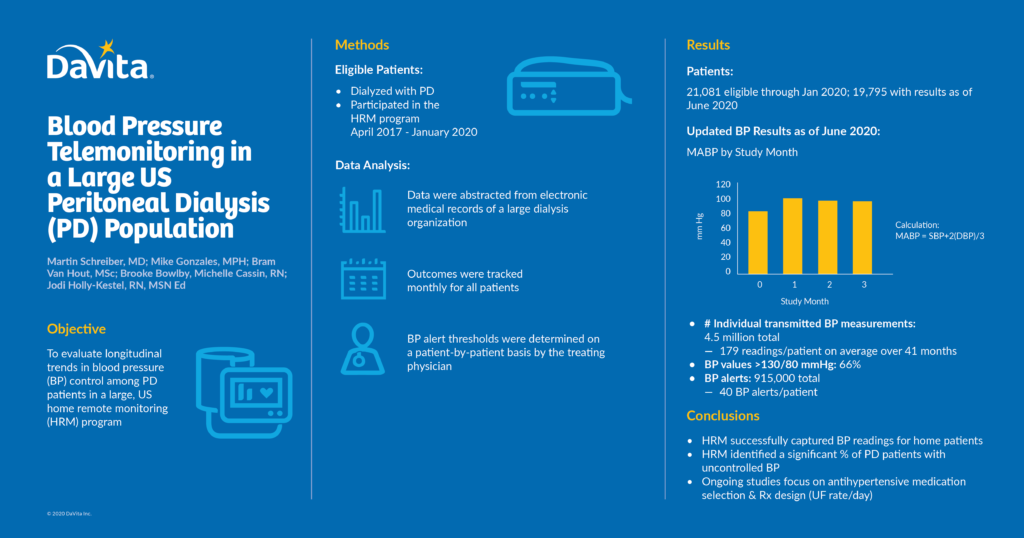Study: Blood Pressure Telemonitoring in a Large US Peritoneal Dialysis (PD) Population

Home remote monitoring (HRM) is a telehealth strategy that utilizes cellular technology to transmit patients’ biometric data collected at home to the electronic health record of their dialysis provider. In April 2017, a HRM program was launched for peritoneal dialysis (PD) patients throughout the United States. This study conducted by the Home Dialysis team of DaVita Kidney Care evaluated longitudinal trends in blood pressure (BP) control among PD patients participating in the HRM program.
As of June 2020, we identified 21,731 HRM patients active since program inception. Of these, 19,795 patients had 90-day BP transmission results. A total of 4.5 million individual BP measurements were transmitted, with 179 readings per patient on average over 41 months. In total, 915,000 BP alerts occurred (40 BP alerts/patient).
The following outcomes were tracked monthly for all patients: mean BP, mean arterial BP (MAPB), number of transmitted BP measurements, number of BP alerts and number of antihypertensive (anti-HTN) medications prescribed. BP alert thresholds were determined on a patient-by-patient basis by the treating physician.
Analysis of the transmitted results noted: 31.5% of patients (pts.) achieved the target BP of less than 130/80 mm Hg (range 110-130mmHg), 13.6% pts. <110mmHg, 41.2% pts. 131-160mmHg and 13.7% pts.>160mmHg. 53% of pts demonstrated MABP< 97 and 47% >=97. We observed 30%, 23%, and 47%, of patients prescribed 0, 1 to 3, and more than 3 anti-HTN medications, respectively. A significant percentage of PD patients did not see an improvement in MABP or improved regulation of BP during the observation period.
In conclusion, HRM can be successfully employed to capture patient BP readings in the home environment. However the HRM results identified a significant percentage of PD patients with uncontrolled BP during the observation period. Considering these results, applying newer technological innovations to analyze BP readings potentially via AI platforms linked to appropriate therapeutic action steps is critical. Ongoing studies are focused on selection of antihypertensive medication classes and appropriate prescription changes to optimize volume status (i.e., ultrafiltration rate/day, and use of current vs target weights). HRM could be a potentially useful component of clinical programs designed to improve BP control and cardiovascular outcomes, but warrant further efforts to optimize control.
For more information, see the ePoster (which was presented at the American Society of Nephrology’s virtual meeting in 2020), here.

Recent Comments